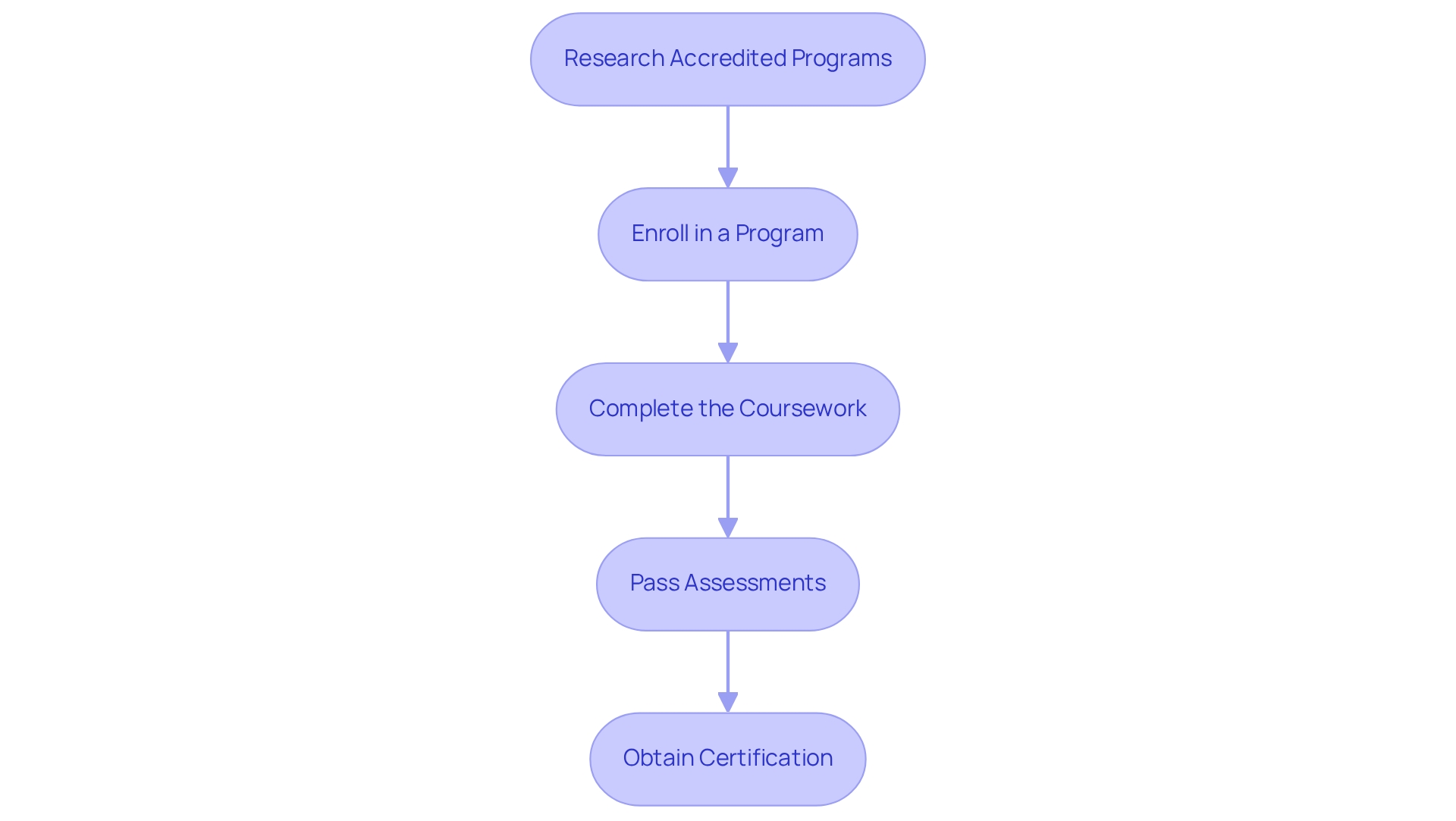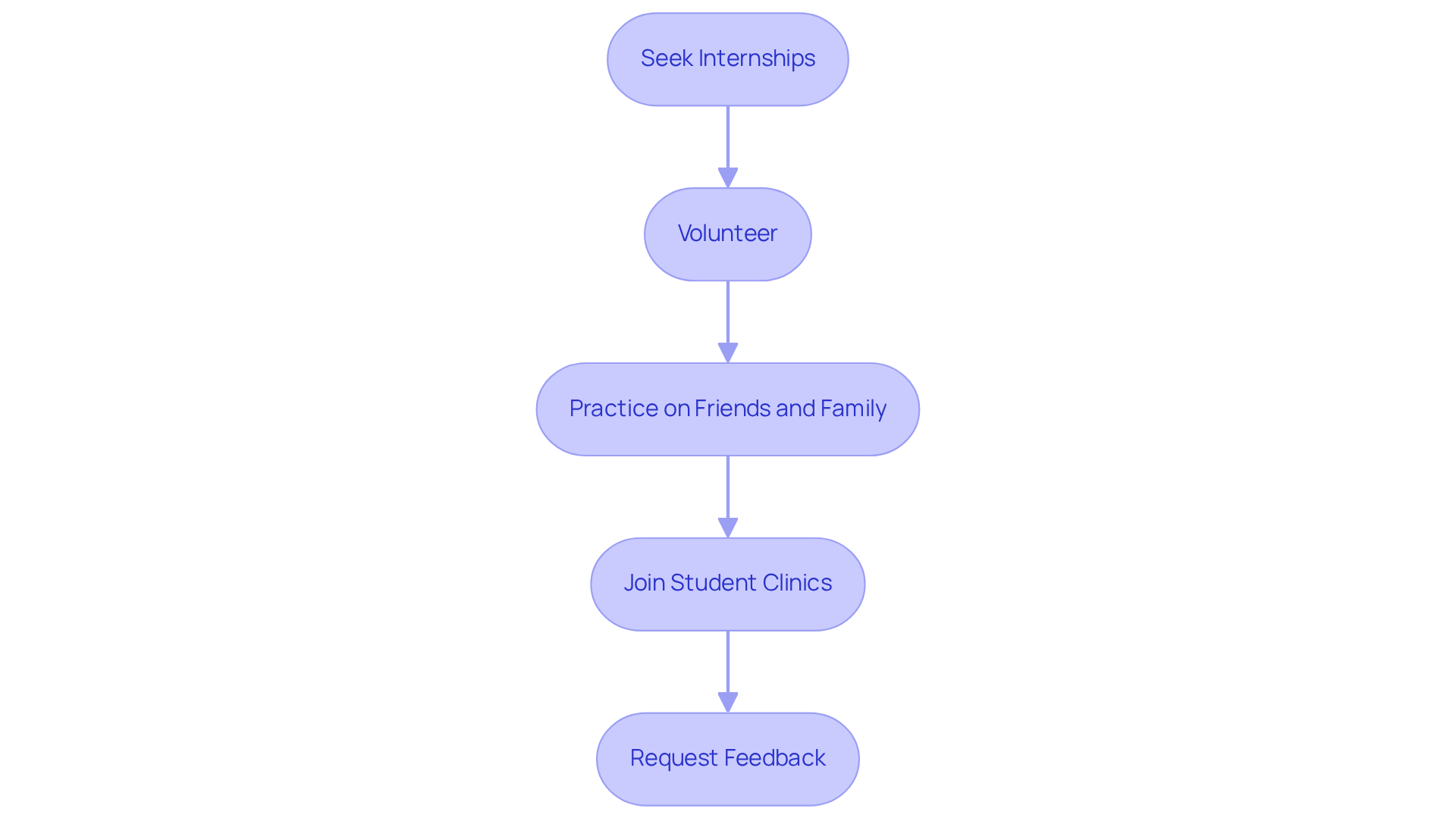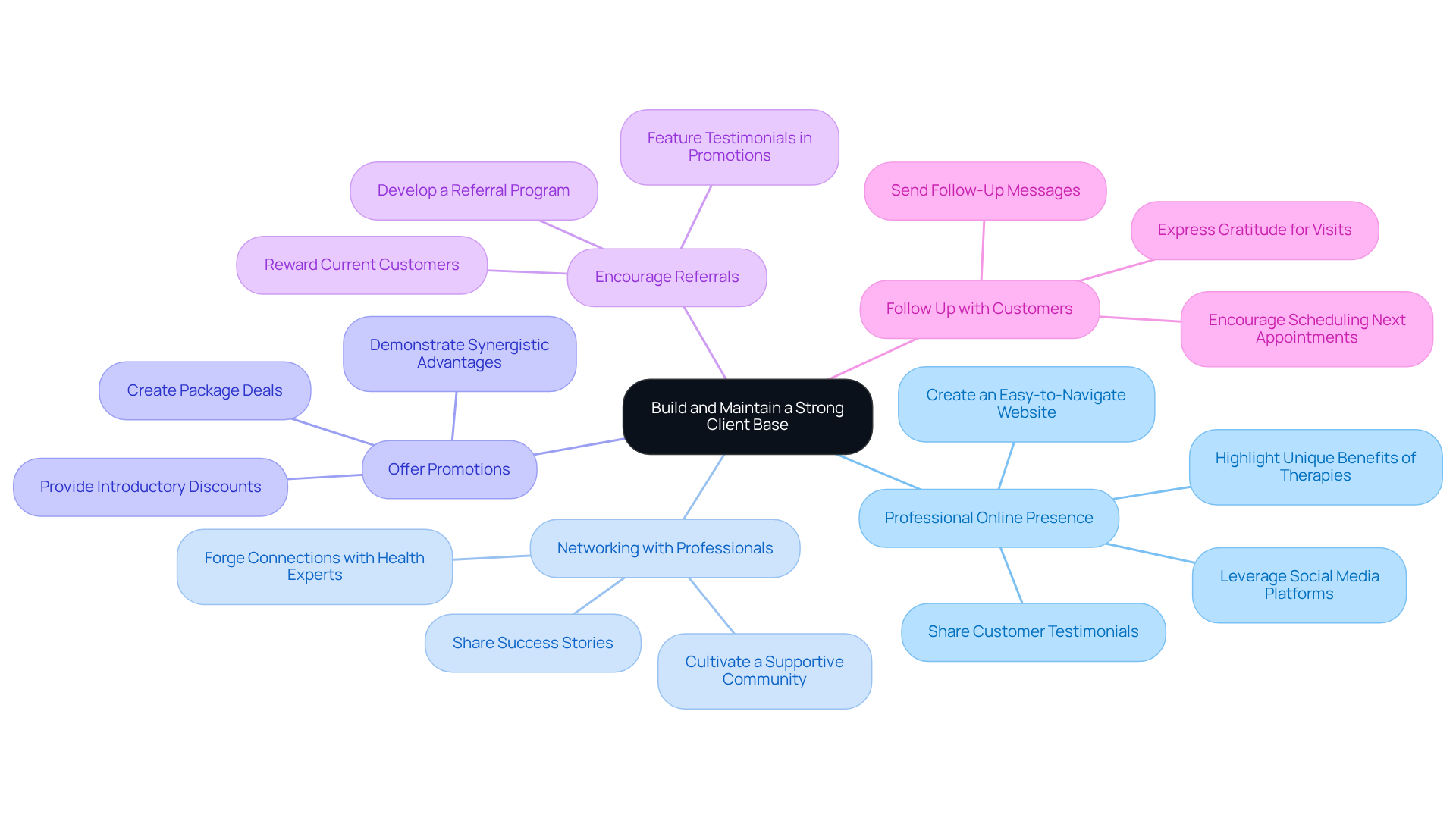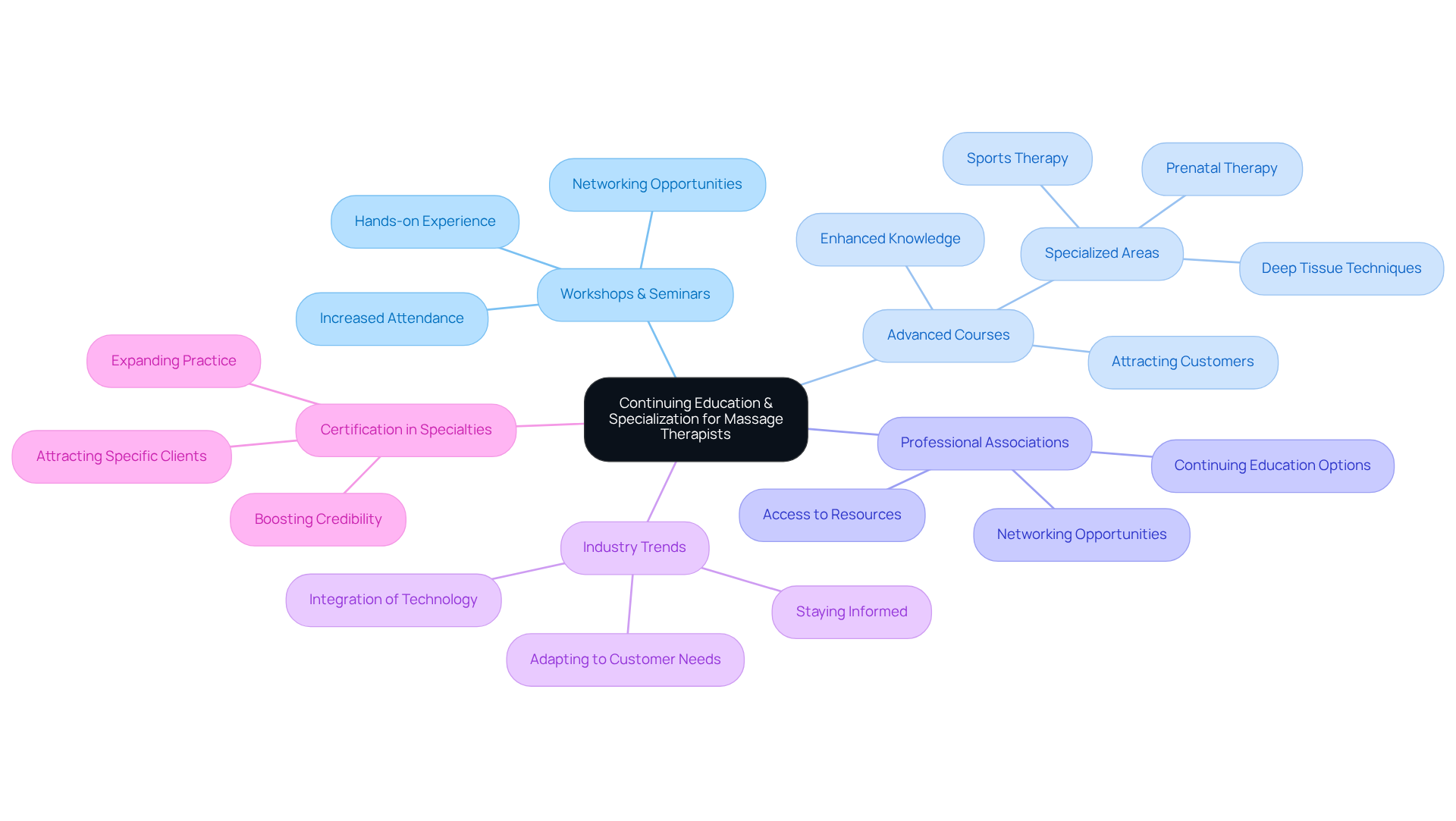Become a Massage Therapist: Essential Steps for Success

Overview
To establish a successful career as a massage therapist, individuals must first complete a recognized training program, such as the Certificate IV in Therapy. This foundational step is essential, but it is equally important to gain practical experience through internships and networking opportunities.
- Structured training
- Hands-on experience
- Cultivation of a robust client base
are not just beneficial; they are crucial for thriving in the competitive field of massage therapy. By following these steps, aspiring therapists can position themselves for success and ensure a rewarding professional journey.
Introduction
Aspiring massage therapists in Australia encounter a landscape abundant with opportunities and challenges as they embark on their professional journey. With the right qualifications and training, including the Certificate IV in Therapy, individuals can acquire essential skills that lay the groundwork for a fulfilling career in bodywork.
However, the road to success transcends formal education; it encompasses:
- Acquiring practical experience
- Cultivating a robust client base
- Dedicating oneself to ongoing professional development
What strategies can aspiring therapists implement to navigate this competitive field and secure their success?
Understand Required Qualifications and Training
Embarking on a career as a bodywork therapist in Australia necessitates the completion of a recognized training program. The minimum requirement is the Certificate IV in Therapy (HLT42021), which encompasses essential skills such as anatomy, physiology, and various therapeutic techniques. To achieve this qualification, follow this structured approach:
- Research accredited programs by identifying institutions that offer the Certificate IV in massage therapy for aspiring massage therapists. It is imperative that these programs are accredited and recognized by relevant professional bodies, as this is crucial for your future practice.
- Enroll in a Program: Once you have selected a suitable program, proceed with the enrollment process. This typically involves submitting an application, paying fees, and providing necessary documentation.
- Complete the Coursework: Engage thoroughly in both theoretical and practical components of the coursework. You will acquire knowledge about various therapeutic techniques, patient evaluation, and ethical practices, which are vital for your development as a practitioner.
- Pass Assessments: Successfully complete all evaluations, including practical exams, to demonstrate your competency in various bodywork techniques. This step is critical, as it validates your skills to potential employers and clients.
- Obtain Certification: Upon finishing your training, you will receive certification, enabling you to practice as a therapist.
In Australia, a significant percentage of massage therapists hold the Certificate IV in Therapy, underscoring its importance within the industry. The introduction of the new Diploma of Remedial Massage (HLT52015) further enhances the qualifications available, merging foundational and advanced theory with practical skills. This diploma is acknowledged by health funds, allowing clients to obtain , thereby motivating more individuals to seek treatment. As the demand for accredited bodywork programs escalates, successful practitioners frequently emphasize the significance of their training in shaping their careers and enhancing their service quality.

Gain Practical Experience Through Internships and Practice
Acquiring hands-on experience is essential for aspiring bodywork practitioners. To build your skills and confidence effectively, consider the following strategies:
- Seek Internships: Explore internship opportunities at wellness centers, spas, or clinics. Numerous bodywork training programs partner with local enterprises to offer students essential practical experience. With nearly in the therapy sector in Australia, internships can significantly enhance your employability in this expanding field.
- Volunteer: Engage in community events or health fairs where you can provide bodywork services. Volunteering not only sharpens your practical skills but also broadens your professional network, which is vital in this competitive arena. Consider participating in events like IRONMAN, where you can connect with other professionals and gain valuable exposure.
- Practice on Friends and Family: Utilize your personal network to practice your techniques. Collaborating with friends and family allows you to refine your abilities in a low-pressure setting, boosting your self-assurance before engaging with clients.
- Join Student Clinics: Many massage therapist training programs feature student clinics where you can practice under the supervision of experienced instructors. This structured environment provides an excellent opportunity to gain experience while still in training.
- Request Feedback: After each session, actively seek input from clients or supervisors. Constructive feedback is invaluable for refining your techniques and enhancing interactions, ultimately leading to superior service delivery. As Cameron Aubrey, Course Director at Discover Massage Australia, emphasizes, mastering the assessment of individuals is crucial for tailoring care and ensuring satisfaction.
By following these steps, you can effectively establish a robust foundation for your healing practice, ensuring you are well-prepared to address the diverse needs of your future patrons.

Build and Maintain a Strong Client Base
To establish and maintain a robust client base, consider implementing the following strategies:
- Establish a Professional Online Presence: Create an easy-to-navigate website and leverage social media platforms to showcase your services, including advanced lymphatic massage and red light treatment. Share customer testimonials and wellness tips. In 2025, a well-optimized online presence is crucial, serving as the first point of interaction for potential customers and enhancing both visibility and credibility. By highlighting the unique benefits of these therapies—such as improved detoxification and enhanced cellular health—you can attract greater interest in the work of a massage therapist.
- Network with Other Professionals: Forge connections with health and wellness experts, such as physiotherapists and chiropractors, who can refer clients to you. Networking not only extends your reach but also cultivates a supportive community conducive to mutual referrals. Sharing success stories from individuals who have benefited from your offerings can further solidify these relationships.
- Offer Promotions: Consider providing introductory discounts or package deals for services like the Slimyonik Air Bodystyler or red light treatment to entice new customers. Such promotions can encourage potential clients to experience your services, increasing the likelihood of repeat visits. For example, a package that a massage therapist offers, combining lymphatic therapy with red light treatment, can effectively demonstrate the synergistic advantages of both therapies.
- Encourage Referrals: Develop a referral program that rewards current customers with discounts or incentives for introducing new clients. For instance, customers can earn credits toward their next massage through successful referrals. This strategy capitalizes on the power of word-of-mouth marketing, which is essential for customer acquisition and retention in the massage therapist industry. Testimonials from can be prominently featured in your promotional materials to further enhance referral opportunities.
- Follow Up with Customers: After a session, send a follow-up message expressing gratitude for their visit and encouraging them to schedule their next appointment. This personal touch demonstrates your appreciation for their business and helps keep you top of mind, contributing to higher client retention rates. As Ben Winford emphasizes, understanding your target audience is vital for developing effective marketing strategies that resonate with them.

Pursue Continuing Education and Specialization Opportunities
To remain competitive and elevate your skills as a massage therapist, actively pursuing and specialization opportunities is essential.
- Attend Workshops and Seminars: Engaging in workshops that introduce new techniques or modalities in bodywork therapy is crucial. These events not only provide hands-on experience but also facilitate networking with industry professionals, thereby enhancing your practical knowledge. Notably, statistics indicate a rise in attendance at workshops and seminars, reflecting a commitment to professional growth among practitioners.
- Enroll in Advanced Courses: Consider advanced training in specialized areas such as sports therapy, prenatal therapy, or deep tissue techniques. Such courses not only enhance your knowledge but also expand your offerings, making you more attractive to prospective customers.
- Join Professional Associations: Membership in professional organizations grants access to valuable resources, networking opportunities, and a variety of continuing education options. These associations often host events that are crucial for professional development and staying current in the field. Furthermore, there is a persistent demand for insurance firms to recognize massage therapy as a vital offering, underscoring the importance of ongoing education in enhancing therapists' credibility and potentially increasing compensation.
- Stay Informed on Industry Trends: Regularly consulting industry publications and following relevant blogs is essential to keep abreast of new research, techniques, and best practices. This knowledge allows you to adjust your practice to meet evolving customer needs and preferences.
- Seek Certification in Specialties: If you discover a particular area of interest, pursuing certification in that specialty not only boosts your credibility but also attracts individuals seeking specific services, thereby expanding your practice. As Jimmy Gialelis, a national board certified clinical practitioner, aptly notes, "It will be wise to learn from various sources and instructors to gain a depth of knowledge to best assist those we serve in this manner."
The massage therapist industry increasingly recognizes the value of specialized skills, with many therapists reporting that targeted training has significantly improved their client outcomes. By investing in your education and specialization, you position yourself as a knowledgeable and trusted professional in the wellness community.

Conclusion
Embarking on the journey to become a massage therapist requires a structured approach that encompasses essential training, practical experience, and ongoing education. Understanding the necessary qualifications and the significance of accredited programs allows aspiring therapists to establish a solid foundation for their careers. This path includes:
- Obtaining the required certifications
- Gaining hands-on experience through internships
- Building a robust client base
- Pursuing specialization opportunities to remain competitive in the field
Key strategies emphasized throughout this article highlight the importance of practical experience, such as internships and volunteer work, in enhancing skills and confidence. Establishing a professional online presence, networking with other health professionals, and implementing effective marketing techniques are crucial for creating and maintaining a loyal client base. Furthermore, the pursuit of continuing education and specialization not only enriches knowledge but also positions therapists as credible and trusted practitioners within the wellness community.
Ultimately, the journey to becoming a successful massage therapist is multifaceted, demanding dedication, continuous learning, and a commitment to client satisfaction. By embracing these essential steps and strategies, individuals can thrive in the ever-evolving landscape of massage therapy, positively contributing to the health and well-being of their clients while advancing their own professional development.
Frequently Asked Questions
What is the minimum qualification required to become a bodywork therapist in Australia?
The minimum qualification required is the Certificate IV in Therapy (HLT42021).
What essential skills are covered in the Certificate IV in Therapy program?
The program covers essential skills such as anatomy, physiology, and various therapeutic techniques.
How can I find accredited programs for the Certificate IV in massage therapy?
You can find accredited programs by researching institutions that offer the Certificate IV in massage therapy and ensuring they are recognized by relevant professional bodies.
What are the steps to obtain the Certificate IV in Therapy?
The steps include researching accredited programs, enrolling in a program, completing the coursework, passing assessments, and obtaining certification.
What does the coursework for the Certificate IV in Therapy involve?
The coursework involves both theoretical and practical components, including knowledge about therapeutic techniques, patient evaluation, and ethical practices.
Why is passing assessments important in the training process?
Passing assessments is important as it demonstrates your competency in various bodywork techniques, validating your skills to potential employers and clients.
What additional qualification is mentioned in the article that enhances bodywork training?
The new Diploma of Remedial Massage (HLT52015) is mentioned as an additional qualification.
What benefits does the Diploma of Remedial Massage provide?
The diploma merges foundational and advanced theory with practical skills and is acknowledged by health funds, allowing clients to obtain rebates for remedial therapies.
How does the training impact the careers of successful bodywork practitioners?
Successful practitioners emphasize the significance of their training in shaping their careers and enhancing the quality of their services.


